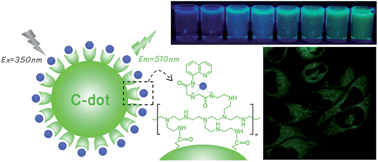Quinoline derivative-functionalized carbon dots as a fluorescent nanosensor for sensing and intracellular imaging of Zn2+†
Abstract
Surface functionalization of nanomaterials with highly specific recognition elements, such as biomolecules and organic molecules, has made possible many novel nanosensors for bio/chemical analysis and target bioimaging. In this report, a fluorescent nanosensor which exhibits highly specific recognition capability towards Zn2+ over competing metal ions has been developed through covalently functionalizing carbon dots (C-dots) with the quinoline derivatives which show response to Zn2+. The nanosensor exhibits excellent water solubility, biocompatibility, and cell-membrane permeability, and demonstrates high selectivity towards Zn2+ with a detection limit as low as 6.4 nM. Additionally, the rapid response of the nanosensor towards Zn2+ can be achieved within 1 min. The large amount of recognition units on the outer surface of an individual nanoparticle enables the signal amplification, hence making the immediate and highly sensitive detection of Zn2+ possible. Therefore, a reliable and highly specific nanosensor has been demonstrated for both rapid quantitative detection of Zn2+ in aqueous solution and real-time imaging of intracellular Zn2+, suggesting its potential and significance in bioanalysis and biomedical detection in the future.

- This article is part of the themed collection: JMC B Top Picks web collection: Seeing the unseen: Advances in bioimaging and biosensors

 Please wait while we load your content...
Please wait while we load your content...